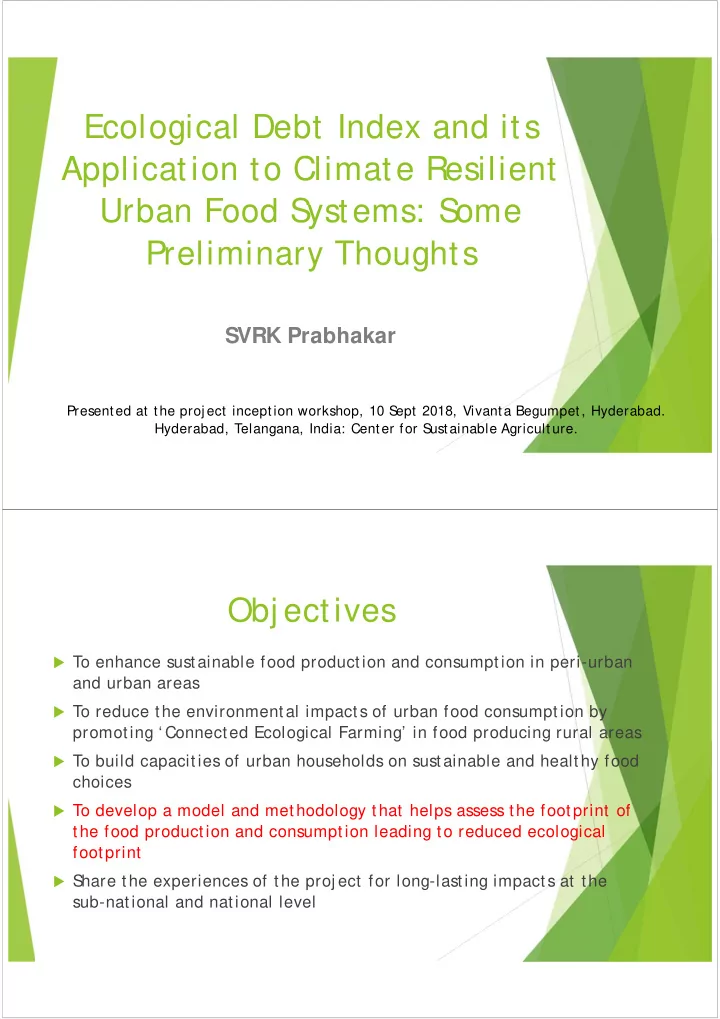

Ecological Debt Index and its Application to Climate Resilient Urban Food S ystems: S ome Preliminary Thoughts SVRK Prabhakar Presented at the proj ect inception workshop, 10 S ept 2018, Vivanta Begumpet, Hyderabad. Hyderabad, Telangana, India: Center for S ustainable Agriculture. Obj ectives To enhance sustainable food production and consumption in peri-urban and urban areas To reduce the environmental impacts of urban food consumption by promoting ‘ Connected Ecological Farming’ in food producing rural areas To build capacities of urban households on sustainable and healthy food choices To develop a model and methodology that helps assess the footprint of the food production and consumption leading to reduced ecological footprint S hare the experiences of the proj ect for long-lasting impacts at the sub-national and national level
Main Activities Establish Food-Info-Marts Establishing nutrient recycling plants Decision support system for Connected Farming Education and capacity building: Consist of two sub-activities Policy advocacy and awareness generation of broader public Food Information Rural Producer Database (FID) Knowledge Policy feedback process Centers (PKCs) Policy Rural Producers Food & Nutrition Experts Food Info-Marts Peri-urban Producers (FIMs) S ustainable Production & Consumption Experts Urban Producers Community Organizations Consumers Food Info-Channels (FICs) Food Resource Channels (FRCs) Policy Feedback Processes From Farm to Plate (life cycle approach)
What is Ecological Debt? Ecological debt is defined as the debt accrued to individual households for satisfying their lifestyle choices away from environmentally sustainable lifestyles (Prabhakar, 2018). Ecological debt index is the difference in the environmental footprint of a household with that of a reference household (Prabhakar, 2018). There are two reference households: Future household: that embodies an ideal household that puts the environment ahead of them and strives to achieve a zero ecological debt depending on the access factors at that time. Sustainability now: household is one that follows all accessible environmental practices to keep their environmental footprint minimum. The Ecological Debt Index Carbon footprint: Energy and other forms of carbon emissions from resources used in production, transport, storage and sale. Food miles: Considers the distance travelled by the food from producer to consumer. S horter the food miles the better it is for the environment. Promoting locally produced food would significantly reduce the food miles. Food waste: Asia accounts significant amount of food waste both in shelves and at consumers end. Reduced food waste means avoided emissions and reduced opportunity cost for those who are affected by such waste. Water footprint: water consumed in production and consumption of food. While pumping water is an energy intensive process, use of excess water puts pressure on limited water resources and has resilience implications. Agrochemical footprint: Chemical fertilisers, pesticides which consumes huge energy in production and also leave residues polluting soils and water crossing the threshold levels Resilience: Measures the resilience gained by both the producers and consumers because of proj ect interventions. Prabhakar, 2018
600 Carbon foot print (t/ HH/ y) Food miles (km/ t/ y) Food waste (t/ year) Water foot print (m3/ y) Chemical foot print (kg/ year) Resilience 500 400 ? ? Units ? 300 200 100 0 Future household S ustainability now household HH 1 HH 2 Normalization of Indicator Values for EDI • The indicator values are to be normalized as indicators differ in units to bring them to a unit-less value • The methodology used for normalization is linear normalization using thresholds within which values of an indicator falls in the real world Normalized indicator value Where ( ) x T x x i is value of the index min i z T min is minimum threshold value of index xi i ( ) ( ) T x T x T max is maximum threshold value of index xi max min
. ( ) CF Index Mean Index * / ( ) * 40 i all i EDI Weight Max Score ( ) Index all Stdev Index i all i . CF . ( ) WFP Index Mean Index * / ( ) * 20 i all i Weight Max Score Index all ( ) Stdev Index i all i . WFP . ( ) CFP Index Mean Index * / ( ) * 10 i all i Weight Max Score ( ) Index all Stdev Index i all i . CFP Re . ( ) s Index Mean Index * / ( ) * 30 i all i Weight Max Score Index all ( ) Stdev Index i all i Re . s Sustainability now household HH 1 HH 2 -36 -37 -38 -39 -40 EDI -41 -42 -43 -44 -45
The Process Develop a questionnaire survey instrument for data collection Baseline survey Regular data collection (monthly) using log-sheets Four randomized control groups Control group (no treatment) FIM only FIM+training FIM+Training+adopted a practice Aspects to be Looked Into Change in household lifestyles All EDI components Any evidence for reduction in food waste? Any evidence for reduction in energy use? Food: Evidence for participation in low carbon food choices Impact on the other aspects of the life. Examples: water consumption reduction, reduction in GHG from transportation, energy consumption etc. (self-reported, indicative data will be used) Change in the amount of food bought from restaurants and other food outlets. Impact on the nutrition of households Is there any change in willingness to pay for environmentally healthy choices?
Which Areas in Hyderabad has high Ecological Debt, which Areas have High Food Production Potential, are they same? This is not a map of EDI! Map source: Govt of Telangana Thank Y ou! prabhakar@ iges.or.j p
Recommend
More recommend